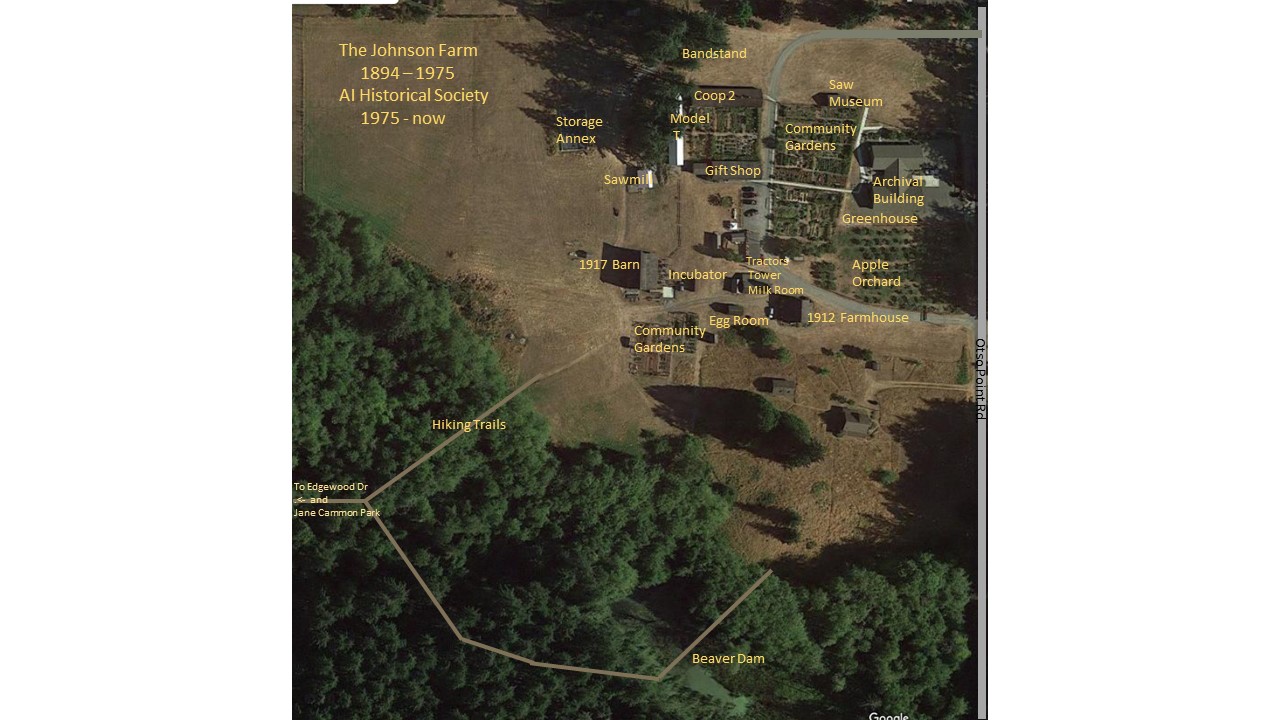Anderson Island Farm, Museum, and Gift Shop


The Farm (1896 - 1975)
The Johnson Farm was established in 1896, when Finnish immigrants John and Alma Marie first built a 2-room cabin. This farm is typical of those developed by many Islanders who raised chickens and dairy herds as a source of income. The Johnsons had four children, and their two sons continued to operate the farm until 1975. The current buildings date from 1912-1920.The Museum Gift Shop
The Gift Shop is located on the farm - in Chicken Coop #1 - at 9306 Otso Point Road (884-2135). Open Saturday (10 AM – 4 PM) and Sunday (12-4 PM) April through December. The Gift Shop carries mugs, jams, candy, and teas, books (new and gently used), children’s toys and games, stationery items, photographs, pottery, glassware, antiques, jewelry and other accessories, kitchen items, and has a Christmas CornerThe Location
Map

The Buildings
Take a walk around the farm, and be sure to visit the Gift Shop located in Chicken Coop #1. A docent from the Anderson Island Historical Society will gladly give you a tour of the Johnson family home and answer any farm-related questions you might have.Water Tower.
At the top of the tower is a wooden tank. The tank was filled by an old Ram Pump located in the pond, down below to the south. The Ram Pump is on display in the barn.Milk Room
The lower part of the tower served as the Milk Room. The separator was used to separate the cream from the milk. The milk was then bottled and placed in the concrete vault to keep it cool until it was sold. The concrete vault had water running through it to provide cooling.Wood Shed
“A wood shed is a wood shed is a wood shed,” presumably with all the mysteries and lore that go with wood sheds. This one still contains wood.Storage Room
In the early days, drums and cans of fuel and oil were stored here. It is now used for general storage.Tool Shed
The tool shed provided an area to store tools and parts, and to make the repairs that were not completed in the field or in the barn.Egg Room.
This is really the heart of the farm, as the primary product was eggs. At the height of the operation, the two large chicken coops at the north end of the property had from 2,000 to 3,000 chickens each. In the early days, the eggs were gathered and brought to the Egg Room to be candled, cleaned, sorted, and packaged by hand. In 1964 the Johnson brothers bought a used egg washing machine. Although it broke a lot of eggs, it did wash, separate by weight, and saved a lot of labor.Maintenance Shed
This is where the Historical Society keeps supplies for the current maintenance program.Brooder Shed
Here we attempt to show the life cycle of the chicken from the incubator through the laying cycle. First, on the left is the incubator. The fertile eggs were placed on the racks inside. They were heated by the heating system attached to the side. When they hatched, they were placed on the floor under the brooder. The Brooder was heated by the heater in the center. The chicks were fed and watered until they became chickens. They were then placed in the large chicken coops where they were fed and watered. At night they would roost on the wire roosts, up off of the floor. When they were ready to lay eggs, they would climb up the ramps and jump into the nests that lined the end walls of the chicken coops. The eggs were then gathered and taken to the Egg Room.The Barn
This barn is unique, since it is a pole barn. The framing is of peeled poles rather than dimensional lumber. It was built in 1917. The stalls housed 12 to 15 cows kept for milking and breeding purposes. The main part of the barn was used for hay. The equipment was either in the field or in other buildings on the farm. There was once a resident Barn Owl who provided the farm with extra income. His regurgitated pellets were sold to the schools for lab work. The barn and associated agricultural buildings have been on the State Heritage Barn Register since 2007.The Logging Wagon in the barn is from Lizzie Larson’s farm, just west of here.